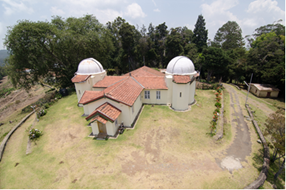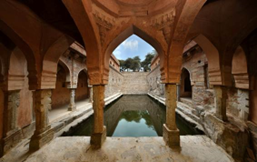Topic-1: Commemorative Stamp on Kodaikanal Solar Observatory (KSO) – 125 Years
GS-3: Science & Technology
The context:
In May 2025, the Department of Posts released a commemorative postage stamp to celebrate 125 years of Kodaikanal Solar Observatory (KSO), recognising its legacy and scientific impact.
About the Kodaikanal Solar Observatory (KSO):
-
- It is located in the Palani Hills of Tamil Nadu, was established on 1 April 1899 and is India’s longest-running astronomical observatory.
- It is operated by the Indian Institute of Astrophysics (IIA), it holds the distinction of being the country’s longest-running astronomical observatory and maintains one of the world’s most extensive and continuous daily records of the Sun.
- The Observatory’s contributions to solar physics are both vast and enduring. Over its 125 years of operation, researchers at KSO have undertaken pioneering studies on sunspots, solar flares, prominences, and the solar corona, significantly enhancing our understanding of solar activity and its influence on Earth.
- It is a fitting tribute to one of India’s most significant scientific institutions and highlights the nation’s long-standing contribution to global science.
- This commemorative stamp honours the Kodaikanal Solar Observatory as a national treasure, celebrating its rich history, remarkable scientific achievements, and unwavering contribution to society.

Source: PIB
Topic-2: Rajon ki Baoli Restoration Projects
GS- 1: Art & Culture
The context:
Recently, a significant step toward protecting India’s cultural and environmental heritage, the Archaeological Survey of India (ASI), in collaboration with the World Monuments Fund India (WMFI) and the TCS Foundation, has successfully completed the conservation work of Rajon ki Baoli, a 16th– century stepwell, located in Mehrauli Archaeological Park, New Delhi.
About the Rajon ki Baoli Restoration Projects:
-
- This project was a part of WMFI’s Historic Water Systems of India initiative, funded by the TCS Foundation, aligning with the World Monuments Fund’s Climate Heritage Initiative.
- It highlights the importance of the restoration of traditional water systems as climate-resilient solutions for sustainable water management.
- Restoration included cleaning, desilting, structural repairs, and fish introduction for water quality, using traditional materials like lime plaster to maintain Lodi-era authenticity.
- Local communities were involved through educational and participatory activities to ensure long-term care and awareness of the Baoli’s cultural and ecological value.
About the Rajon ki Baoli:
-
- It is built around 1506 during the Lodi dynasty.
- It is stands as a testament to Lodhi-era architecture and traditional water
- This four-tiered step well was thoughtfully designed not only to store water but also to offer shade and rest to travellers.
- Its elegant arched colonnades, ornate stucco medallions with floral and geometric patterns, and finely carved stone elements reflect the artistic sophistication of the time.
- It is spanning across the area of 1,610 square meters, this Baoli descends to a depth of 13.4 meters, with the main tank measuring 23 by 10 meters at its base.

Source: PIB
Topic-3: Akashteer – India’s New Defence Edge
GS- 3: Defence Technology, Indigenisation of Defence, Security Challenges
The context:
India successfully deployed Akashteer, its fully indigenous, automated Air Defence Control and Reporting System, to intercept and neutralise missile and drone attacks during Pakistan’s Operation SINDOOR on May, 2025.
About Akashteer:
-
- It is India’s fully indigenous, automated Air Defence Control and Reporting System, that intercepted and neutralised every inbound projectile.
- The system provides a common, real-time air picture to all involved parties (control room, radars and Defence Gun), enabling coordinated air defense operations.
- It is a system designed to automate detection, tracking and engagement of enemy aircraft, drones and missiles.
- It integrates various radar systems, sensors and communication technologies into a single operational framework.
- Akashteer is part of the broader C4ISR (Command, Control, Communications, Computers, Intelligence, Surveillance and Reconnaissance)framework, working in coordination with other systems.
- The system is vehicle-based which makes it mobile and easier to handle in hostile environment.
- Akashteer enables autonomous monitoring of low-level airspace in battle zones and efficient control of Ground-Based Air Defence Weapon Systems.
- Akashteer is the core of the Indian Army’s Air Defence (AAD) system. It connects smoothly with IACCS (Indian Air Force) and TRIGUN (Indian Navy), creating a clear and real-time picture of the battlefield. This enables the quick and effective use of both offensive and defensive weapons.
- It is part of a growing ecosystem of indigenous defence platforms that are reshaping India’s war-fighting capabilities. The Make in India initiative has bolstered growth and enabled the development of advanced military platforms including the Dhanush Artillery Gun System, Advanced Towed Artillery Gun System (ATAGS), Main Battle Tank (MBT) Arjun, Light Specialist Vehicles, High Mobility Vehicles, Light Combat Aircraft (LCA) Tejas, Advanced Light Helicopter (ALH), Light Utility Helicopter (LUH), Weapon Locating Radar, 3D Tactical Control Radar, and Software Defined Radio (SDR), as well as naval assets like destroyers, indigenous aircraft carriers, submarines, frigates, corvettes, fast patrol vessels, fast attack craft, and offshore patrol vessels.

India’s Defence Manufacturing Revolution: Toward Self-Reliance
-
- India targets ₹3 lakh crore in defence production by 2029, reinforcing its position as a global defence manufacturing hub.
- The private sector plays a crucial role, contributing 21% to total defence production, fostering innovation and efficiency.
- A robust defence industrial base includes 16 DPSUs, over 430 licensed companies, and approximately 16,000 MSMEs, strengthening indigenous production capabilities.
- 65% of defence equipment is now manufactured domestically, a significant shift from the earlier 65-70% import dependency, showcasing India’s self-reliance in defence.
Source: PIB
Spread the Word
